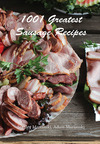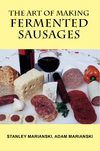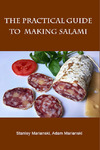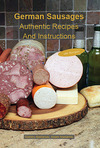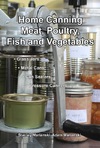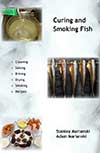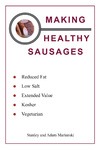Meats and Sausages
Pickled Vegetables and Fruits
Pickled vegetables and fruits, commonly known as pickles, are made from fruits and vegetables or their combinations. They are preserved with vinegar, lemon juice or citric acid. Bacteria will not grow in strong acidic environment and this rule applies to fruits, vegetables and fast fermented meat products. The natural fermentation is a lengthy process and to preserve foods fast we have to increase acidity of the product by other methods. Generally, pickled foods are made with vinegar in varying proportions and are canned in glass jars using the boiling water processing. Vinegar imparts a characteristic acidic flavor which is usually offset by the careful selection of fruits and adding sugar. In addition to cabbage and cucumbers, other vegetables can be successfully naturally fermented. Root vegetables such as radish, turnip, and beets are very healthy and ferment easily with salt alone. They will retain all nutrients, minerals and vitamins as long as they are not subjected to thermal processing.
Pickled foods are classified into the following groups:
Fermented Pickles - usually cucumbers, but other vegetables may be employed. Vegetables are placed in a salt solution for several weeks until fermented. Curing time largely depends on temperature. During this time, changes in color, flavor and texture take place.
Unfermented Pickles - also known as Quick Pickles or Fresh Pack Pickles. The vinegar in the recipe preserves the fruit or vegetable. You can make vegetables directly into pickles without soaking in salt brine, or you can soak them a short time.
Relishes - fruits, vegetables or their combinations. Sweet relishes contain more sugar. Pickles and relishes are very similar. For pickles, you leave vegetables whole, or cut them according to the recipe. For relishes, however, you chop vegetables and/or fruits before you put them into a vinegar mixture.
Fruit Pickles - whole or sliced fruits like peaches, pears, watermelons, figs and other fruits are heated in a spicy sweet-sour syrup.
Chutneys - fruit and vegetables or their combinations. Chutneys are usually strongly spiced. Chutney is also classified as a type of jam.
Sauce - usually vegetables, they can be mild or hot. Very popular sauces can be pickled such as Tomato Ketchup Sauce, Chili Sauce, Red Pepper Sauce, Taco Sauce and others.
Sweet pickles are prepared in much the same manner as other pickles, except that vinegar is sweetened and more spices are added. Sometimes portions of vinegar are drained and sweet spicy liquid is added a little at a time until the desired sweetness is obtained.
Quick pickles are made from fresh fruits and vegetables. Quick pickles are not fermented. Vinegar, sugar and spices are added. Then the pickles are pasteurized. Quick pickling requires at least as much vinegar as other liquids. For pickling purpose brine, fruit or vegetable juice are all considered water and must be matched with an equal amount (or more) of vinegar. The United States Department of Agriculture (USDA) recommends that homemade pickles contain at least 70% acetic acid (pH 4.0 or less).
For many years the USDA has been publishing professionally compiled and thoroughly tested recipes which can be followed down to the letter. To write one's own recipe and be on the safe side, the recommendation is to have at least a 1:1 vinegar to water ratio. For calculation purposes other liquids such as fruit or vegetable juices are considered to be water and should be mixed with an equal amount of vinegar.
The USDA recommends processing quart size jars at 180° F (82° C) for 30 minutes or at 212° F (100° C) for 15 minutes at 0-1000 ft above sea level. During the heat process oxygen will be eliminated and the resulting vacuum will prevent yeasts and molds from spoiling pickles.
Because acidity and heat treatment are the main safety hurdles against spoilage in canned pickles, the amount of salt can be negotiable. This may sound attractive to people on a low sodium diet. They can use commercially produced blends of sodium chloride (common salt) and potassium chloride to reduce the salt content in half. Keep in mind that changing salt levels may bring changes to the texture of the pickles.



